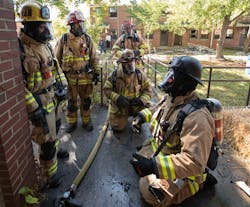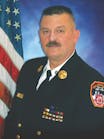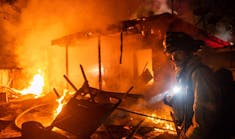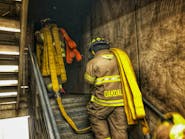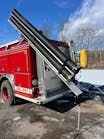Know the Nozzle Team
A fire victim’s best chance for survival is when the first-arriving engine company makes an aggressive interior attack. As such, the single most important tactic on the fireground is putting water on the fire to eliminate the fire problem as quickly as possible. Positioning the apparatus, establishing a positive water source, placing the first line in operation are all components that will determine the success of the initial fire attack and the overall operation.
Every position on the first-due engine is critical. Individual department staffing levels will dictate how engine responsibilities are assigned. In rural fire departments, the staffing levels may only be an officer, chauffeur and one firefighter. To mount an initial interior fire attack, the first-due engine may have to be augmented with additional personnel from the next-arriving units.
An ideal engine staffing level is an officer, chauffeur, nozzle, backup, door and control firefighters. NFPA 1710 recommends that each company be staffed with four firefighters. In the case of limited staffing levels (two or three firefighters), a single firefighter may have to perform multiple tasks.
No matter how positions are assigned, basic responsibilities must be accomplished. Each assignment is critical to the overall team effort, and if any of the links are broken, the advancement and extinguishment of the fire will be delayed or not accomplished.
Duties of a fully staffed crew
The following is a brief description of the responsibilities of an engine company:
- Engine officer (can assume the responsibilities of backup firefighter or nozzle firefighter): They handle communications, determine handline size and the most direct path to attack the seat of the fire, call for the line to be charged, direct the handline, monitor the progress of the fire attack and fire conditions, and determine if fire conditions are untenable and the line must back out, when the fire is knocked down (no visible flame) and final extinguishment.
- Chauffeur: The chauffeur is responsible for driving the apparatus, ensuring a safe response, positioning the engine, establishing a supply line, hooking up to a hydrant, putting the apparatus in pump, and supplying handlines at proper pressure.
- Nozzle firefighter: This person stretches the initial length(s), flakes out initial length(s), opens and operates the nozzle, determines the pace of the fire attack, and directs the nozzle.
- Backup firefighter (responsibilities can be assumed by engine officer): This member stretches length(s), flakes out their length(s), ensures that the nozzle firefighter’s lengths are flaked out, and provides physical support to the nozzle firefighter by absorbing as much nozzle pressure as possible to ensure a steady advance upon the fire.
- Door firefighter (responsibilities can also be assumed by control firefighter): This person stretches any remaining lengths of hose, aids in flaking out hoseline, chases kinks in the line, ensures that the nozzle and backup firefighters have enough hose to reach the seat of the fire, monitors fire conditions, conserves air supply and energy, moves up on the line and relieves nozzle or backup firefighter if they become fatigued or injured.
- Control firefighter: This member assists the chauffeur in acquiring water supply, hooks up to hydrant connection or standpipe, monitors hose stretch, chases kinks in the line, conserves air supply and energy, moves up on the line, relieves nozzle or backup firefighter if they become fatigued or injured, and if the officer calls for the use of a dead hose load, they determine the number of lengths used.
Nozzle team
At the heart of an aggressive interior fire attack is a determined nozzle team with a warrior’s attitude. The nozzle team is responsible for getting to the seat of the fire and protecting everyone operating on the fireground, giving trapped fire victims a chance to survive. Specifically, the nozzle team must protect interior teams conducting primary searches on the fire floor and the floor or floors above. If left unchecked, the fire will continue to advance, creating an environment of rapidly deteriorating fire conditions.
Ideally, the nozzle team is a three-member team—engine officer, nozzle firefighter and backup firefighter. As previously stated, for departments with reduced staffing levels, the nozzle team may have the officer performing simultaneous duties of officer and backup firefighter, or officer and nozzle firefighter, thus creating a two-person nozzle team. For obvious reasons, a three-member team will operate more efficiently and be able to make a more efficient push on the fire.
Let’s discuss the nozzle team in greater detail.
Engine officer
Mental demeanor
To command a nozzle team through a fire, it is important that the engine officer be a leader who has had experience as a nozzle firefighter. They need to have experienced the intense heat, the fatigue of the biceps and shoulders, the searing steam, the heat through the facepiece, the heat on the shoulders, the burning of your knees. Knowing what the nozzle firefighter is experiencing and understanding the position of directing the water stream allows the officer to make sound decisions. The engine officer must realize that the nozzle team is responsible for the overall safety of everyone operating in the structure.
Physical positioning
Leaders lead from the front. The physical position of the engine officer is adjacent or tucked in between the nozzle firefighter and the backup firefighter. I like to keep a hand on the nozzle firefighter’s shoulder, as this allows me to give physical direction, and allows me to communicate by slapping the firefighter’s back to open the line, shut the line or back out. The physical position is dependent upon the space in which the nozzle team is operating (open space vs. tight hallway). At times, the officer may need to move in front of the line or duck into an open space so as not to get hit by the stream. The position is never outside of the building or two or three firefighters back from the nozzle. The officer needs to feel the heat and observe the fire conditions. The nozzle firefighter’s facepiece is often obscured by steam and falling debris. Ideally, the officer is using a TIC during the operation.
Duties
The officer’s duties involve size-up, including building dimensions, occupancy type, building construction, volume of fire, diameter of hose, above or below grade, number of stories, standpipe or hand stretch, and location of fire in the structure.
The engine officer must work in unison with the inside team from the truck in locating the fire. If there is no available truck company, the engine officer must team up with another available firefighter to find the fire.
Once the location is established, if possible, the door to the fire area should be closed to confine the fire. The engine officer should communicate number of lengths needed and location. When the officer meets up with the nozzle and backup firefighters, they should communicate information (i.e., “up the stairs, first door on the left,” “down the hall, second apartment on the right,” “fire is in rear bedroom 20 feet in”).
Before the nozzle team commences the fire attack, the officer must ensure that each firefighter is bunkered up (hood donned, earflaps down, collar up). Heat will find any exposed skin and will impede the aggressiveness and progress of the fire attack. Further, when directing the fire attack, the officer must make sure that the nozzle team is low-crawling or using a duck walk.
During extinguishment operations, it is vital that the officer continually monitors the fire environment and adjusts the attack accordingly. The officer must make sure that the team did not pass the fire and the fire does not get behind the team.
The officer’s communication to the incident commander (IC) is vital to the overall fireground operation (i.e., “Engine 1 to Command, we have water on the fire,” “Engine 1 to Command, all visible fire is knocked down,” “Engine 1 to Command, we are backing out”).
Nozzle firefighter
Mental demeanor
The nozzle firefighter should exhibit courage, unrelenting determination, a can-do attitude, and willpower to succeed. The nozzle position is the most challenging position on the fireground. In an advanced fire condition, no one is more exposed to heat and flame than the nozzle firefighter. Thus, no one can move in front of the nozzle. The nozzle firefighter must understand the responsibility they are faced with and know everyone is depending upon them to accomplish the mission.
Physical position
The nozzle firefighter must stay low, crouched, crawl or duck walk. They should stay out of the flue, and as quickly as possible when entering the immediate fire area, move to the side of the entrance, as this will allow the heat, smoke and gases to escape.
Duties
The nozzle firefighter should stretch the first length(s) to the fire area. If you are the nozzle firefighter, never stretch a dry line into the fire area! Always bleed the line (open nozzle to release air in the line) before opening the nozzle on the fire. Make sure that if you are using a fog nozzle, it is in the straight-stream position. In an advanced fire condition—fire is blowing out the front door on the porch—use the reach of the stream to knock down the fire. If fire is coming out of the bedroom at the top of the stairs, hit the fire from the bottom of the stairs. If the fire is extending down a public hallway in a multiple dwelling, operate the nozzle and knock down the fire as you advance. Advance the line as close to the fire as possible before opening the nozzle. Try not to open the nozzle on smoke.
If while advancing to the fire area the nozzle firefighter begins to feel uncomfortable in their gear—shoulders begin to burn, hands begin to burn—this may be a precursor to flashover. It is critical to open the nozzle, as a few short bursts of water will push the fire gases back and interrupt the thermal layer. When operating the nozzle, make sure you have enough hose out in front of you. Operate the nozzle in a clockwise motion, hit the ceiling and sweep the floor. When it begins to get hot, get lower. I have operated at fires on my belly, and wish I could have dug a hole in the floor to escape the heat. Remember that you are responsible for everyone, especially any firefighters who are working on the floor(s) above. The nozzle team may not be able to advance, but it is vital to hold the position until members can safely exit the building. We did not sign up to get killed, and some fires are impossible to extinguish. Always consider the risk vs. the reward.
Backup firefighter
Mental demeanor
The backup firefighter provides support and encouragement to the nozzle firefighter. They are the enthusiastic coach saying, “Great job, you got it, keep moving in.” They should be ready to take over the nozzle position if the nozzle firefighter gets injured or fatigued.
Physical position
They should be as close to the nozzle firefighter as possible, with either their arm or shoulder on the nozzle firefighter’s back.
Duties
The backup firefighter should flake out the nozzle firefighter’s remaining line and flake out their own length(s). They must push hard enough to absorb the nozzle reaction, but not too hard that they knock over the nozzle firefighter. The backup firefighter must hold the line with both hands to facilitate the nozzle firefighter’s advance. They should move in the opposite direction of the nozzle.
In sum
As the saying goes, there are many ways to skin a cat. Departments successfully employ indirect fire attacks, some use combination attack strategies. There is much debate on the subject. I believe a department should use the tactic that they practice and at which they have become proficient. That tactic will work the best.
The next time you roll up and there is fire blowing out four windows square, hopefully these basics will aid you. Stay low!
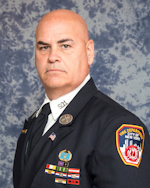
Paul Mastronardi
Paul Mastronardi is a 21-year member of the FDNY, currently serving as a lieutenant assigned to Squad Co. 1 Special Operations Command, an instructor at the FDNY Technical Rescue School, and as a deputy assistant chief for the Suffolk County Fire Academy. He has a bachelor’s degree in education from Hofstra University.
